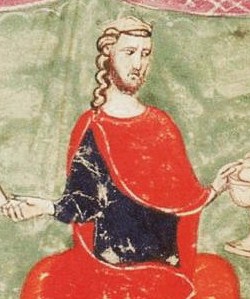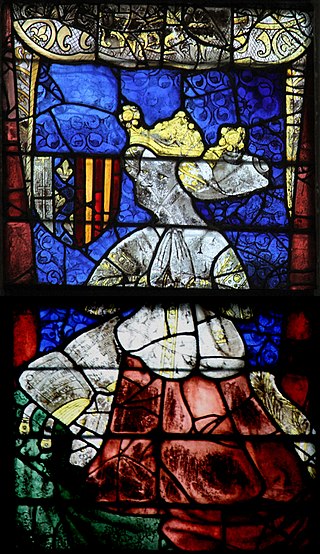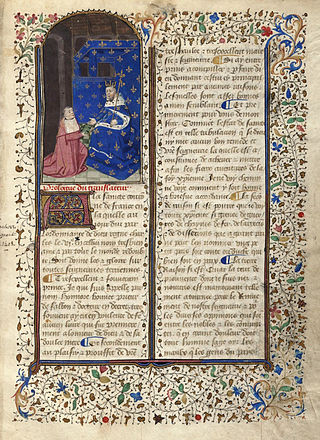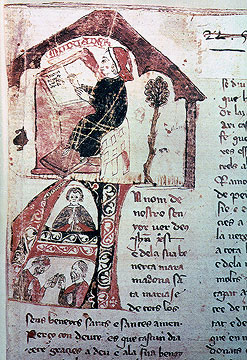
Alfonso the Magnanimous was King of Aragon and King of Sicily and the ruler of the Crown of Aragon from 1416 and King of Naples from 1442 until his death. He was involved with struggles to the throne of the Kingdom of Naples with Louis III of Anjou, Joanna II of Naples and their supporters, but ultimately failed and lost Naples in 1424. He recaptured it in 1442 and was crowned king of Naples. He had good relations with his vassal, Stjepan Kosača, and his ally, Skanderbeg, providing assistance in their struggles in the Balkans. He led diplomatic contacts with the Ethiopian Empire and was a prominent political figure of the early Renaissance, being a supporter of literature as well as commissioning several constructions for the Castel Nuovo.

Peter III of Aragon was King of Aragon, King of Valencia, and Count of Barcelona from 1276 to his death. At the invitation of some rebels, he conquered the Kingdom of Sicily and became King of Sicily in 1282, pressing the claim of his wife, Constance II of Sicily, uniting the kingdom to the crown.

René of Anjou was Duke of Anjou and Count of Provence from 1434 to 1480, who also reigned as King of Naples as René I from 1435 to 1442. Having spent his last years in Aix-en-Provence, he is known in France as the Good King René.

Charles II, also known as Charles the Lame, was King of Naples, Count of Provence and Forcalquier (1285–1309), Prince of Achaea (1285–1289), and Count of Anjou and Maine (1285–1290); he also styled himself King of Albania and claimed the Kingdom of Jerusalem from 1285. He was the son of Charles I of Anjou—one of the most powerful European monarchs in the second half of the 13th century—and Beatrice of Provence. His father granted Charles the Principality of Salerno in the Kingdom of Sicily in 1272 and made him regent in Provence and Forcalquier in 1279.

The Kingdom of Naples, also known as the Kingdom of Sicily, was a state that ruled the part of the Italian Peninsula south of the Papal States between 1282 and 1816. It was established by the War of the Sicilian Vespers (1282–1302), when the island of Sicily revolted and was conquered by the Crown of Aragon, becoming a separate kingdom also called the Kingdom of Sicily. This left the Neapolitan mainland under the possession of Charles of Anjou. Later, two competing lines of the Angevin family competed for the Kingdom of Naples in the late 14th century, which resulted in the death of Joanna I by Charles III of Naples. Charles' daughter Joanna II adopted King Alfonso V of Aragon as heir, who would then unite Naples into his Aragonese dominions in 1442.

The Crown of Aragon was a composite monarchy ruled by one king, originated by the dynastic union of the Kingdom of Aragon and the County of Barcelona and ended as a consequence of the War of the Spanish Succession. At the height of its power in the 14th and 15th centuries, the Crown of Aragon was a thalassocracy controlling a large portion of present-day eastern Spain, parts of what is now southern France, and a Mediterranean empire which included the Balearic Islands, Sicily, Corsica, Sardinia, Malta, Southern Italy and parts of Greece.

Yolande of Aragon was Duchess of Anjou and Countess of Provence by marriage, who acted as regent of Provence during the minority of her son. Yolande played a crucial role in the struggles between France and England, influencing events such as the financing of Joan of Arc's army in 1429 that helped tip the balance in favour of the French. She was also known as Yolanda de Aragón and Violant d'Aragó. Tradition holds that she commissioned the famous Rohan Hours.

Frederick, sometimes called Frederick IV or Frederick of Aragon, was the last king of Naples from the Neapolitan branch of the House of Trastámara, ruling from 1496 to 1501. He was the second son of Ferdinand I, younger brother of Alfonso II, and uncle of Ferdinand II, his predecessor.

Louis III was a claimant to the Kingdom of Naples from 1417 to 1426, as well as count of Provence, Forcalquier, Piedmont, and Maine and duke of Anjou from 1417 to 1434. As the heir designate to the throne of Naples, he was duke of Calabria from 1426 to 1434.

The coat of arms of Spain represents Spain and the Spanish nation, including its national sovereignty and the country's form of government, a constitutional monarchy. It appears on the flag of Spain and it is used by the Government of Spain, the Cortes Generales, the Constitutional Court, the Supreme Court, and other state institutions. Its design consists of the arms of the medieval kingdoms that would unite to form Spain in the 15th century, the Royal Crown, the arms of the House of Bourbon, the Pillars of Hercules and the Spanish national motto: Plus Ultra. The monarch, the heir to the throne and some institutions like the Senate, the Council of State and the General Council of the Judiciary have their own variants of the coat of arms.

The rule of tincture is a design philosophy found in some heraldic traditions that states "metal should not be put on metal, nor colour on colour". Heraldic furs such as ermine and vair, and charges described as "proper", are generally exempt from the rule of tincture.

Francesco Laurana, also known as Francesco de la Vrana was a Dalmatian sculptor and medallist. He is considered both a Croatian and an Italian sculptor. Though born in the territory of the Republic of Venice, he spent his mature career at the other end of Italy, moving between Naples and Sicily, and Urbino, and finally in southern France, where he died.

The War of the Sicilian Vespers, also shortened to the War of the Vespers, was a conflict waged by several medieval European kingdoms over control of Sicily from 1282 to 1302. The war, which started with the revolt of the Sicilian Vespers, was fought over competing dynastic claims to the throne of Sicily and grew to involve the Crown of Aragon, Angevin Kingdom of Naples, Kingdom of France, and the papacy.

Marcus Vulson de la Colombière or Sieur de la Colombière was a French heraldist, historian, poet and member of the royal court. His name is sometimes spelled as Wulson or Volson.

Hatching is a conventional system for monochrome denotation of heraldic armory, whereby the tinctures (colours) are represented by dots and lines. This technique is employed in cases where colours, for either aesthetic, practical or economic reasons are not reproduced – e.g. on surfaces such as woodcuts or engravings, seals and coins.

Honoré Bonet was a Provençal Benedictine, the prior of Salon near Embrun.
Clément Prinsault was a 15th-century French heraldist.
The Spanish monarchs of the House of Habsburg and Philip V used separate versions of their royal arms as sovereigns of the Kingdom of Naples-Sicily, Sardinia and the Duchy of Milan with the arms of these territories.

Claude-Nicolas Le Cat was a French surgeon and science communicator.

The Chronicle of Ramon Muntaner, written by the Catalan burgher and administrator Ramon Muntaner in Xirivella, Kingdom of Valencia, in 1325–1328, is the longest in the series of four "great" Catalan-language chronicles of the 13th and 14th centuries. It narrates events relating to the history of the Crown of Aragon and to Muntaner's personal career in Iberia, Sicily, the Aegean and North Africa and spans the period from the conception of James I of Aragon in May 1207 to the coronation of Alfonso IV of Aragon in April 1328. Its character of "mirror of princes" and "mirror of citizens" has been pointed out by scholars.